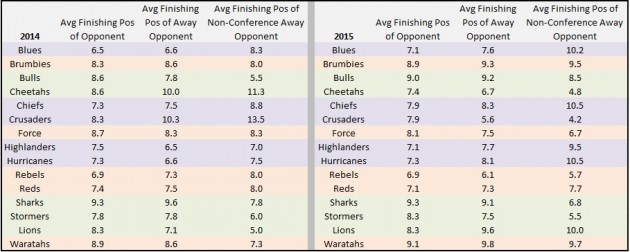The 20th season of Super Rugby begins in February and with the tournament expanding to 18 teams in 2016, this will be the fifth and final time that the 15 side format is seen.
Identifying a potential winner is a trickier prospect than in the Aviva Premiership, Guinness Pro12 or Top 14 leagues, thanks to a few unique characteristics of the competition.
As can be seen below, the sporting cliché that ‘defence wins championships’ doesn’t apply in Super Rugby. Instead, the rugby statistics show that any team with aspirations of lifting the trophy in July will likely require the best attack in the regular season.
The team with the top offence has won in 14 of the previous 19 seasons and each champion has been rated at least fourth for points scored. In contrast, the best defence has only won four titles and on each occasion they also possessed the best attack. Eight of those previous winners had a defence graded at sixth or worse.
The average defence rank of a Pro12 winner is 2.3, Premiership 2.7 and Top14 3.1. However, in Super Rugby it is 4.6 with the runner up having a superior 3.1.
The idea of a ‘level playing field’ and financial equality is a major talking point in the Premiership at the moment. The concept of fairness would also stretch to the fixtures, with every team playing each other, home and away. That isn’t the case in Super Rugby though, where the draw is a significant factor.
The Crusaders have consistently been one of the highest scoring teams in the competition, with a top three attack in 16 previous seasons. Having reached at least the semi-final stage in every year since 2002 and lost by just a single point against the Waratahs in the most recent final, they will surely be well backed again in 2015. However it is worth noting that in 2014, the average finishing position of their away opposition was 10.3. On paper, that worked out as the easiest schedule and indeed they won six of their eight regular season trips.
While there is clearly no guarantee that teams will perform the same this year, if using 2014 finish places as a guide – then this year the Crusaders would have the toughest away fixture, with an average finishing position of 5.6. In terms of non-conference away opponents, it is the difference between visiting the Lions, Cheetahs, Reds and Rebels last year and Bulls, Sharks, Brumbies and Waratahs in this campaign.

Try Machine: Nemani Nadolo scored 12 tries in 14 matches for the Crusaders in 2014 and 7 in 7 Tests for Fiji
If strength of opposition is a key factor, then the same can be said of placement of bye weeks and how the home and away matches are split. Travelling across different time-zones, coping with altitude and having to manage a long away tour in a different country are all issues that coaches in other domestic rugby competitions don’t have to deal with.
New Zealand teams had a record of seven wins and two draws from 20 matches when travelling abroad last year in the regular season, Australian teams had five wins and South African sides – just the three victories. The latter stat isn’t really that surprising given the South African teams have to play four consecutive away tour games.
Looking at the above 2015 fixtures, the Blues are away seven times in ten matches at the start of their campaign, not an easy start for a team that has won away just twice in the previous two years. At the other extreme, the Bulls are at home in five of their opening six contests and don’t leave South Africa until week 14. With a record of 15 wins and a draw from their previous 16 regular season home games, it might be expected that Frans Ludeke’s team set the pace early in their conference.

Raging Bull: with Pierre Spies set to return from injury, will the Bulls make a strong start to 2015?
Under Jamie Joseph, the Highlanders have tended to start well and then fade in the latter stages of the tournament. Since 2011 and ignoring the nightmare 2013 season, the team have a 70% win rate in the first nine rounds which drops to 29% from round ten onwards. This 2015 schedule may see that trend continue. They are at home in five of the first six matches and then have a long run of ten matches without a bye to manage at the end.
The Cheetahs, Waratahs and Sharks are also teams that will face a ten match stretch, due to when their bye weeks occur. The Reds have a split of five, five and six games between byes which is surely favourable to the nine games-bye-seven matches-bye fixture sequence that the Lions have been landed with. It is obviously a small sample of data, but the longest chain of matches between byes for the previous four winners in the conference system era is nine.

Value?: A star of the 2014 ITM Cup, Chiefs signing Seta Tamanivalu scored 7 tries and beat 54 defenders for champs Taranaki
At the risk of an obvious pick, the Chiefs do look to be a strong contender this year. Having identified a need for size in the back-line, coach Dave Rennie has brought in Bryce Heem, Hosea Gear, Sonny Bill Williams and Seta Tamanivalu. It is unlikely they will need to field ten different midfield combinations as they did in 2014 and the team should fit the criteria of being at least a top 4 attack. Their away schedule is slightly improved on last season and they have a week off to prepare for a crucial conference match against at the Crusaders in week ten.
Hail to the Chiefs, again?








